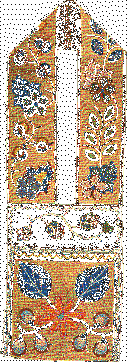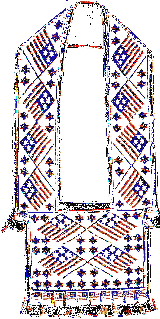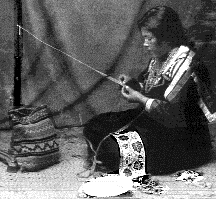Ojibwe Embroidered Beadwork Bandoliers
 |
Colored backgrounds were sometimes made because those were the only beads the maker had enough of. Or the artist may have preferred a colored background. This Ojibwe bandolier may have come from Lac du Flambeau reservation (Wisconsin). It was probably made around 1890. The color combination is subtle and beautiful. The pattern, an original creation of the artist, is stylistically similar to the flowers used by Maude Kegg in the 1980's, but the central design is simpler. Almost all bags have swinging tassels, loom-beaded tabs etc. across the bottom to sway in dancing the bag. This one may have been damaged, its bottom tabs removed. NMAI collection. |
|---|---|
| | |
 |
This bandolier is identified as Ojibwe from th NMAI collection in 500 Nations (Josphy, Alfred A. Knopf, 1994). Where Maude Kegg's white beads are in rows so even it might almost be loom beading, the field beads here are somewhat lumpy, about like I make them -- having beaded for only a little over 20 years! See full-size detail NMAI collection. |
| | This unusual pattern makes flowers from hexagonal "tiles". There is no data on this bag, which is in the NMAI collection. It was probably made around 1890, the great period for these bandolier bags. NMAI identifies the bag as Ojibwe but there is no further info about it. See detail. |  |
| | |
 | There's no date for this flags bandolier, which is in the National Museum of the American Indian. It was probably made before World War II (when beadwork underwent a substantial decline), perhaps to honor a veteran of World War I. It is quite possible it was made in the late 19th century, since the American flag was considered a symbol of power and was incorporated in many ritual designs. The idea was to take or placate the power of the military forces of the invaders. Note that the flags have 4 (the sacred number) stars. The beadwork is very fine. See detail NMAI recently ID's this as Winnebago on its web pages; I think it's Ojibwe. |
| | |
 "The writer watched the drawing of a design by Mrs. [Zosed] Razer [of Red Lake, Minnesota reservation, 1910]. Much thought was bestowed on the selection and arrangement of the cut patterns. The design began at the left, after which the right end was decided upon and the cut patterns were then arranged in the intervening space. These were connected by scrolls drawn in [flour] paste. In preparation, the velvet was basted to calico to give it firmness." -- Frances Densmore, Chippewa Customs, 1929 "The writer watched the drawing of a design by Mrs. [Zosed] Razer [of Red Lake, Minnesota reservation, 1910]. Much thought was bestowed on the selection and arrangement of the cut patterns. The design began at the left, after which the right end was decided upon and the cut patterns were then arranged in the intervening space. These were connected by scrolls drawn in [flour] paste. In preparation, the velvet was basted to calico to give it firmness." -- Frances Densmore, Chippewa Customs, 1929 | |
|---|---|
| |
 |
This Ojibwe woman was probably photographed by Frances Densmore around 1908, at the White Earth (Minnesota) reservation. She is a good transition for us between bead applique embroidery -- how all these bags were made -- and the next section, Ojibwe woven beadwork bags. Across her knee is draped a finished embroidery beaded floral bandolier strap, not yet sewed to the strap backing. |
| She is working with a heddle-style bead loom -- mazinabidoigan -- a thing that makes pictures or designs, perhaps to weave the narrow tabs that dangle at the bottom of many fine bandoliers. In front of her is a big white plate in which she has an assortment of beads pulled off their hank-strings; to the side of that, a few bead-hanks as they are still purchased today by those who use lots of beads. For a bit of extra display, leaning against the heddle post is a handsome woven yarn-string bag, which she probably keeps her supplies and projects in. Ojibwe women used to do that kind of weaving without looms. | |
Text and graphics copyright 1995, 1996.
 This curvelinear flower, fruit, and leaves is one of a whole set of paper patterns belonging to Mrs. Razer, her daughter and (eventually, perhaps) grandaughter. Densmore remarks rather disparagingly that she thinks the original source for these is some chintz fabrics the traders had brought. Although she doesn't go quite so far as to call these designs "chintzy", she doesn't like the big fully-beaded florals.
This curvelinear flower, fruit, and leaves is one of a whole set of paper patterns belonging to Mrs. Razer, her daughter and (eventually, perhaps) grandaughter. Densmore remarks rather disparagingly that she thinks the original source for these is some chintz fabrics the traders had brought. Although she doesn't go quite so far as to call these designs "chintzy", she doesn't like the big fully-beaded florals.